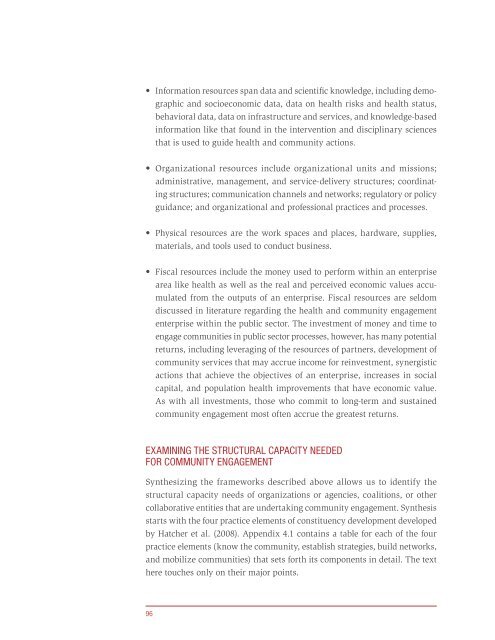Principles of Community Engagement (Second Edition)
Principles of Community Engagement (Second Edition)
Principles of Community Engagement (Second Edition)
You also want an ePaper? Increase the reach of your titles
YUMPU automatically turns print PDFs into web optimized ePapers that Google loves.
• Information resources span data and scientific knowledge, including demo-<br />
96<br />
graphic and socioeconomic data, data on health risks and health status,<br />
behavioral data, data on infrastructure and services, and knowledge-based<br />
information like that found in the intervention and disciplinary sciences<br />
that is used to guide health and community actions.<br />
• Organizational resources include organizational units and missions;<br />
administrative, management, and service-delivery structures; coordinating<br />
structures; communication channels and networks; regulatory or policy<br />
guidance; and organizational and pr<strong>of</strong>essional practices and processes.<br />
• Physical resources are the work spaces and places, hardware, supplies,<br />
materials, and tools used to conduct business.<br />
• Fiscal resources include the money used to perform within an enterprise<br />
area like health as well as the real and perceived economic values accumulated<br />
from the outputs <strong>of</strong> an enterprise. Fiscal resources are seldom<br />
discussed in literature regarding the health and community engagement<br />
enterprise within the public sector. The investment <strong>of</strong> money and time to<br />
engage communities in public sector processes, however, has many potential<br />
returns, including leveraging <strong>of</strong> the resources <strong>of</strong> partners, development <strong>of</strong><br />
community services that may accrue income for reinvestment, synergistic<br />
actions that achieve the objectives <strong>of</strong> an enterprise, increases in social<br />
capital, and population health improvements that have economic value.<br />
As with all investments, those who commit to long-term and sustained<br />
community engagement most <strong>of</strong>ten accrue the greatest returns.<br />
EXAMINING THE STRUCTURAL CAPACITY NEEDED<br />
FOR COMMUNITY ENGAGEMENT<br />
Synthesizing the frameworks described above allows us to identify the<br />
structural capacity needs <strong>of</strong> organizations or agencies, coalitions, or other<br />
collaborative entities that are undertaking community engagement. Synthesis<br />
starts with the four practice elements <strong>of</strong> constituency development developed<br />
by Hatcher et al. (2008). Appendix 4.1 contains a table for each <strong>of</strong> the four<br />
practice elements (know the community, establish strategies, build networks,<br />
and mobilize communities) that sets forth its components in detail. The text<br />
here touches only on their major points.

















